|
 Laccaria proxima Laccaria proxima
SynonymsClitocybe proxima
Laccaria laccata
Laccaria procera
BiostatusPresent in region - Exotic
Images (click to enlarge)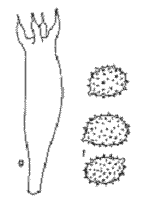
Caption: L. proxima: f, spores; g, basidium | 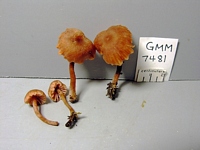
Caption: Laccaria proximella?: 7481: PILEUS: 12-32 mm diam, convex, depressed, finely fibrillose, sulcate to disc, dark reddish brown. LAMELLAE: adnate, distant, thick, 4 mm broad, entire, vinaceous. STIPE: 30-40 x 3 mm, equal, glabrous, concolorous with pile
Owner: Greg Mueller | 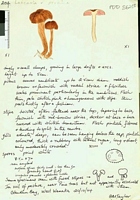
Caption: Watercolour
Owner: G.M. Taylor | 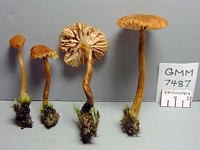
Caption: Laccaria proximella / proxima: 7487: PILEUS: 12-30 mm diam, broadly convex, some sightly depressed, finely fibrillose, not striate to finely translucent near margin, orange brown (between 6&7d8); margin decurved, undulate; context 2-3 mm thick at disc, c
Owner: Greg Mueller | 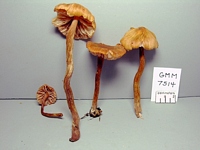
Caption: Laccaria proximella / proxima: 7514: see photo, relatively large, organge brown, stipe stongly twisted fibrillose stipe; spores elongate with short echinulae
Owner: Greg Mueller | 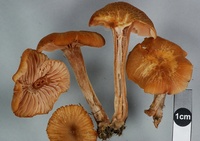
Owner: J.A. Cooper |
Article: McNabb, R.F.R. (1972). The Tricholomataceae of New Zealand. 1. Laccaria Berk. & Br. New Zealand Journal of Botany 10(3): 461-484 (http://www.rsnz.org/publish/abstracts.php).
Description: PILEUS: 2-5.5 cm diam., hemispherical when young, convex
to plano-convex at maturity, hygrophanous, non-viscid, faintly pellucid-striate
at margins when young and wet, not so at maturity and when dry, subglabrous
to finely furfuraceous particularly near centre, brick red to reddish brown,
drying pallid fawn to buff. Cuticle composed of unspecialised, repent, parallel
or slightly interwoven, thin-walled, clamped hyphae 5.5-14 µm diam. LAMELLAE:
adnexed to adnate, distant, thick, intermixed, to 1.5 cm deep, flesh pink, glaucous.
STIPE: 3-9 cm long, ± equal or slightly tapering apically, 3-6 mm diam., dry,
hollow, often contorted, coarsely longitudinally fibrillose giving stipe a silky
sheen, reddish brown; flesh concolorous, basal mycelium white.
SPORES: spore print white when fresh; spores broadly
elliptical, rarely subglobose, often slightly depressed on one side, apiculate,
hyaline, inamyloid, finely echinulate, 8-10.5-(12) X 7.5-9.5 µm including spines,
spines to 0.7-(l) µm long. HYMENIUM: basidia subclavate to clavate, 32-5 X 8-11
µm, 4-spored, sterigmata to 8 µm long; paraphyses numerous, simple, cylindrical
to subclavate or irregular, to 4.5 µm diam., often projecting to base of sterigmata.
HYMENOPHORAL TRAMA: regular, composed of tinted, ± parallel, long-celled hyphae;
clamp connections present. CONTEXT OF PILEUS: thin, reddish brown. SMELL AND
TASTE: not distinctive. CHEMICAL CHARACTERS : FeSO4 on pileus and context—rapidly
dark grey; KOH and NH4OH on pileus and context—n.r.
Habitat: Gregarious to caespitose under introduced conifers.
Notes: The epithet proxima has usually been applied
to a species closely resembling Laccaria laccata but of larger stature,
with mainly elliptical spores less than 10 µm in longest dimension, and with
spines to 1 µm long. However, Singer (1967) published a different interpretation
of L. proxima based on a collection from the French Jura. He regards
it as a species with rather coarsely echinulate, elliptical spores (10)-l 1-12.8
X 7.5-9.5 µm including spines, spines (1.2)-1.5-(2) µm long, and possessing
numerous filamentous or subclavate paraphyses. Singer's interpretation of L.
proxima agrees closely with the protologue in macroscopic characters, but
it should be noted that Boudier described the spores of his fungus as finely
and shortly echinulate. The fungus with smaller, finely echinulate spores, usually
described under L. proxima, was regarded by Singer (1967) as possibly
a large form of L. laccata var. laccata. New Zealand collections
agree closely with Singer's interpretation of L. proxima, except that
the spore ornamentation is slightly shorter.
L. proxima is an introduced species and has been found only in association with exotic
conifers. It is characterised by the large stature, reddish brown pileus and
stipe, and broadly elliptical spores. The species has not previously been recorded
from New Zealand.
Article: Stevenson, G. (1964). The Agaricales of New Zealand: V. Kew Bulletin 19(1): 1-59.
Description: This usually brick-red species is the commonest toadstool in New Zealand
occurring under both native and exotic woody vegetation at all times of the
year. Singer (1951) describes the spores as ellipsoid or globose, not more than
10 µm, with spines less than. 1 µm. long. The writer has examined specimens L.
laccata in The Kew Herbarium which show the following spore characters:-
(1)
coll. J. E. C. Aberdeen, Queensland, 4.8.1952;
spores globose, 8-9 µm diam., spines in, close-set.
(2)
coll. R. W. G. Dennis, Portugal, 16.10.1955;
spores ovoid 8-9 x 10-11 µm, spines 0.5 µm.
(3)
Herbarium Berkeley, coll. in Tasmania; spores
ovoid 8-9 x 10-11 µm, spines 0.5 µm.
Lange (1935) describes the spores of C. (Laccaria)
laccata var. proxima, as ovate-globose, minutely echinulate, 7.5-9 x
6.75-7.5 µm, with spines 1 µm long, but mentions also collections with large
globose, spores and comments, probably the form of the spore is not constant;
Rea (1922) states that both elliptical and globose spores have been found on
the same plant, but this does not seem to have been confirmed and is contrary
to the writer's observations.
New Zealand collections which have been examined usually have globose
spores, 9-10 µm diam., with well-developed spines, but ovoid spores have also
been seen. More information about the distribution of spore forms in relation
to macroscopic characters would be interesting.
Notes: This mixed description also incorporates L. ohiensis
|